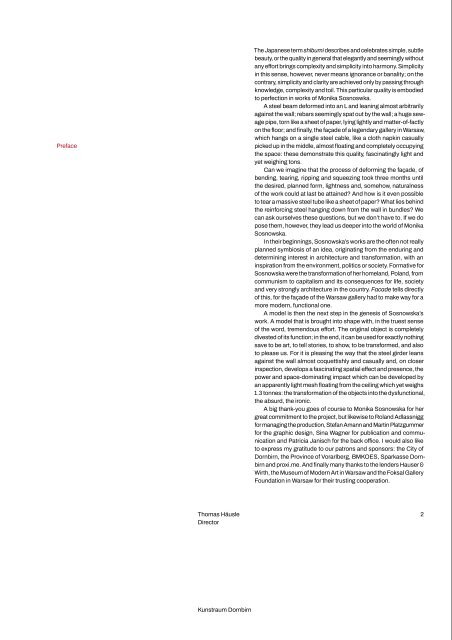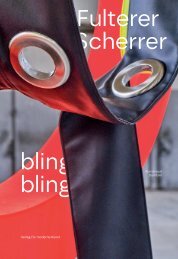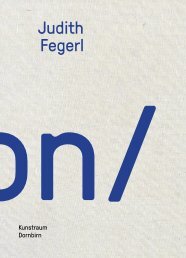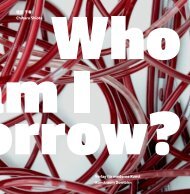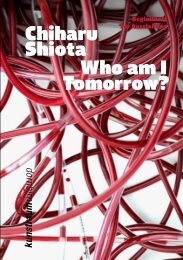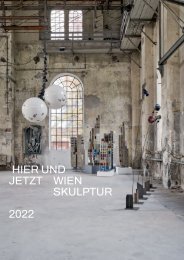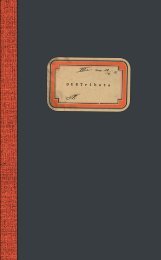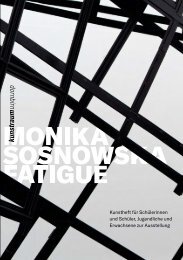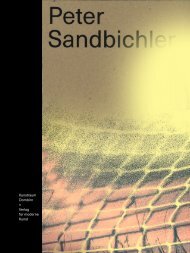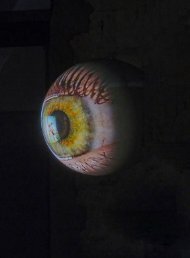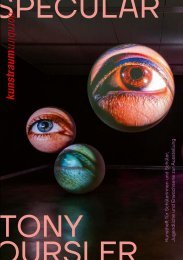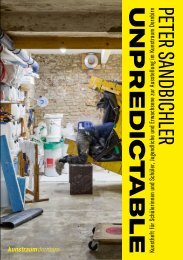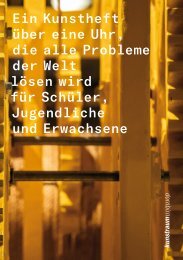Katalog: Monika Sosnowska "Fatigue"
Der Katalog erscheint anlässlich der Ausstellung "Fatigue" der polnischen Künstlerin Monika Sosnowska im Oktober 2022.
Der Katalog erscheint anlässlich der Ausstellung "Fatigue" der polnischen Künstlerin Monika Sosnowska im Oktober 2022.
- Keine Tags gefunden...
Sie wollen auch ein ePaper? Erhöhen Sie die Reichweite Ihrer Titel.
YUMPU macht aus Druck-PDFs automatisch weboptimierte ePaper, die Google liebt.
Preface<br />
Thomas Häusle<br />
Director<br />
Kunstraum Dornbirn<br />
The Japanese term shibumi describes and celebrates simple, subtle<br />
beauty, or the quality in general that elegantly and seemingly without<br />
any effort brings complexity and simplicity into harmony. Simplicity<br />
in this sense, however, never means ignorance or banality; on the<br />
contrary, simplicity and clarity are achieved only by passing through<br />
knowledge, complexity and toil. This particular quality is embodied<br />
to perfection in works of <strong>Monika</strong> Sosnoswka.<br />
A steel beam deformed into an L and leaning almost arbitrarily<br />
against the wall; rebars seemingly spat out by the wall; a huge sewage<br />
pipe, torn like a sheet of paper, lying lightly and matter-of-factly<br />
on the floor; and finally, the façade of a legendary gallery in Warsaw,<br />
which hangs on a single steel cable, like a cloth napkin casually<br />
picked up in the middle, almost floating and completely occupying<br />
the space: these demonstrate this quality, fascinatingly light and<br />
yet weighing tons.<br />
Can we imagine that the process of deforming the façade, of<br />
bending, tearing, ripping and squeezing took three months until<br />
the desired, planned form, lightness and, somehow, naturalness<br />
of the work could at last be attained? And how is it even possible<br />
to tear a massive steel tube like a sheet of paper? What lies behind<br />
the reinforcing steel hanging down from the wall in bundles? We<br />
can ask ourselves these questions, but we don’t have to. If we do<br />
pose them, however, they lead us deeper into the world of <strong>Monika</strong><br />
<strong>Sosnowska</strong>.<br />
In their beginnings, <strong>Sosnowska</strong>’s works are the often not really<br />
planned symbiosis of an idea, originating from the enduring and<br />
determining interest in architecture and transformation, with an<br />
inspiration from the environment, politics or society. Formative for<br />
<strong>Sosnowska</strong> were the transformation of her homeland, Poland, from<br />
communism to capitalism and its consequences for life, society<br />
and very strongly architecture in the country. Facade tells directly<br />
of this, for the façade of the Warsaw gallery had to make way for a<br />
more modern, functional one.<br />
A model is then the next step in the genesis of <strong>Sosnowska</strong>’s<br />
work. A model that is brought into shape with, in the truest sense<br />
of the word, tremendous effort. The original object is completely<br />
divested of its function; in the end, it can be used for exactly nothing<br />
save to be art, to tell stories, to show, to be transformed, and also<br />
to please us. For it is pleasing the way that the steel girder leans<br />
against the wall almost coquettishly and casually and, on closer<br />
inspection, develops a fascinating spatial effect and presence, the<br />
power and space-dominating impact which can be developed by<br />
an apparently light mesh floating from the ceiling which yet weighs<br />
1.3 tonnes: the transformation of the objects into the dysfunctional,<br />
the absurd, the ironic.<br />
A big thank-you goes of course to <strong>Monika</strong> <strong>Sosnowska</strong> for her<br />
great commitment to the project, but likewise to Roland Adlassnigg<br />
for managing the production, Stefan Amann and Martin Platzgummer<br />
for the graphic design, Sina Wagner for publication and communication<br />
and Patricia Janisch for the back office. I would also like<br />
to express my gratitude to our patrons and sponsors: the City of<br />
Dornbirn, the Province of Vorarlberg, BMKOES, Sparkasse Dornbirn<br />
and proxi.me. And finally many thanks to the lenders Hauser &<br />
Wirth, the Museum of Modern Art in Warsaw and the Foksal Gallery<br />
Foundation in Warsaw for their trusting cooperation.<br />
2<br />
3<br />
Einfach ist oft einfach gut!<br />
Thomas Häusle<br />
Direktor<br />
Kunstraum Dornbirn<br />
Der japanische Begriff Shibumi beschreibt und feiert die einfache,<br />
subtile Schönheit oder überhaupt die Eigenschaft, welche elegant<br />
und scheinbar mühelos Komplexität und Einfachheit in Einklang<br />
bringt. Einfachheit bedeutet in diesem Sinne aber niemals Unwissenheit<br />
oder Banalität, vielmehr werden dabei Wissen, Komplexität<br />
und Mühsal durchmessen, um in der Einfachheit und Klarheit<br />
anzukommen. Diese besondere Qualität repräsentieren <strong>Monika</strong><br />
<strong>Sosnowska</strong>s Werke in Perfektion.<br />
Ein beinahe beliebig an die Wand gelehnter, zu einem L verformter<br />
Stahlträger, Bewehrungsstäbe die von der Wand scheinbar<br />
ausgespuckt werden, ein riesiges Abwasserrohr, das wie ein Blatt<br />
Papier zerrissen, leicht und flüchtig am Boden liegt, und schließlich<br />
die Fassade einer legendären Galerie in Warschau, die einer<br />
beiläufig in der Mitte aufgehobenen Stoffserviette gleich an einem<br />
einzigen Stahlseil hängend, fast schwebend den Raum ganz und<br />
gar in Anspruch nimmt, belegen diese Qualität faszinierend leicht<br />
und doch tonnenschwer.<br />
Können wir uns vorstellen, dass der Prozess des Verformens<br />
der Fassade, des Biegens, Zerrens, Reißens und Quetschens, drei<br />
Monate gedauert hat, bis endlich die gewünschte, geplante Form,<br />
Leichtigkeit und irgendwie Selbstverständlichkeit des Werkes erreicht<br />
werden konnte? Und wie ist es möglich, ein massives Stahlrohr<br />
mal eben zu zerreißen wie ein Blatt Papier? Was steckt alles hinter<br />
dem aus der Wand gebündelt herabhängenden Armierungsstahl?<br />
Das können wir uns fragen, müssen wir aber nicht. Tun wir es doch,<br />
führt es uns tiefer in die Welt der <strong>Monika</strong> <strong>Sosnowska</strong>.<br />
<strong>Monika</strong> <strong>Sosnowska</strong>s Arbeiten sind am Anfang die oft nicht<br />
wirklich geplante Symbiose aus einer Idee, entsprungen dem<br />
dauerhaften und bestimmenden Interesse an Architektur und<br />
Transformation, sowie einer Inspiration aus Umwelt, Politik und/oder<br />
Gesellschaft. Prägend für die Künstlerin waren die Transformation<br />
ihrer Heimat Polen vom Kommunismus zum Kapitalismus und die<br />
Folgen für das Leben, die Gesellschaft und auch stark die Architektur<br />
in dem Land. „Facade“ erzählt direkt davon, denn die Fassade der<br />
Galerie musste einer moderneren, funktionsfähigeren weichen.<br />
Ein Modell ist dann der nächste Schritt in der Genese von <strong>Sosnowska</strong>s<br />
Arbeiten. Ein Modell, das anschließend mit – im wahrsten<br />
Sinne des Wortes – gewaltigem Aufwand traktiert in Form gebracht<br />
wird. Der ursprüngliche Gegenstand wird dabei vollständig seiner<br />
Funktion beraubt – er ist am Ende zu exakt nichts mehr zu gebrauchen,<br />
außer Kunst zu sein, zu erzählen, zu zeigen, transformiert<br />
zu sein und auch uns zu gefallen.<br />
Gefallen kann, dass der Stahlträger fast schon kokett beiläufig<br />
an der Wand lehnt und bei näherer Betrachtung eine faszinierende<br />
Raumwirkung und Präsenz entwickelt; welche Kraft und raumbeherrschende<br />
Wirkung ein vermeintlich leichtes von der Decke<br />
schwebendes Geflecht entwickeln kann, das doch 1,3 Tonnen<br />
wiegt; oder die Transformation der Gegenstände ins Dysfunktionale,<br />
Absurde, Ironische.<br />
Großer Dank für großes Engagement gilt selbstverständlich<br />
<strong>Monika</strong> <strong>Sosnowska</strong>, aber auch Roland Adlassnigg für die Leitung<br />
der Produktion, Stefan Ammann und Martin Platzgummer für das<br />
Grafikdesign, Sina Wagner für Publikation und Kommunikation<br />
sowie Patricia Janisch für das Backoffice. Danken möchte ich<br />
unseren Fördergebern und Sponsoren – Stadt Dornbirn, Land<br />
Vorarlberg, BMKOES, Sparkasse Dornbirn, proxi.me. Großer<br />
Dank gilt den Leihgebern Hauser & Wirth, Museum of Modern Art<br />
in Warschau und der Foksal Gallery Foundation in Warschau für<br />
die vertrauensvolle Zusammenarbeit.


